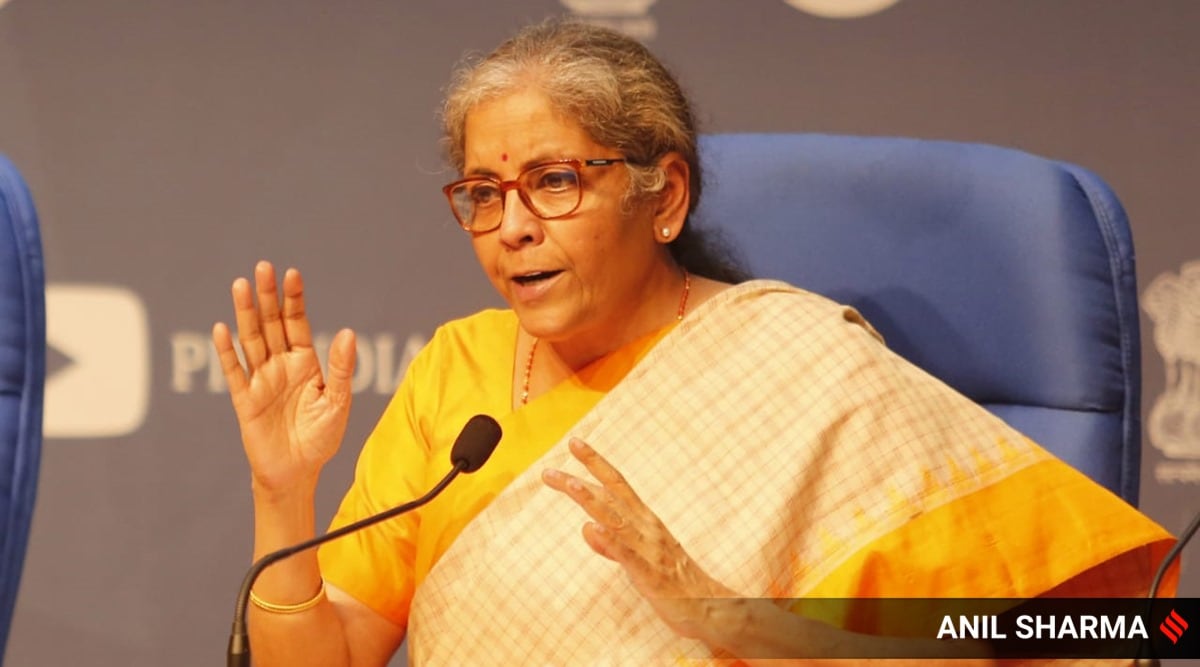 Finance Minister Nirmala Sitharaman.
Finance Minister Nirmala Sitharaman.Written by Sameet Panda and Vipul Kumar
In her final announcement of the Atmanirbhar Bharat package on November 12, Finance Minister Nirmala Sitharaman stated that the “One Nation One Ration Card (ONORC)” scheme now covers 68.8 crore beneficiaries under the Public Distribution System (PDS) across 28 states and Union territories. The scheme is touted as bringing inter-state portability of ration to all PDS beneficiaries, significantly easing the process for migrant workers.
The ONORC was launched by the government in June 2019 with the aim of reforming the current system, where a PDS beneficiary could only withdraw foodgrain from the fair-price shop (FPS) where her ration card was tagged. Prior to its launch, a new PDS portability system called Integrated Management of PDS (IMPDS) was rolled out in April 2018. The IMPDS allows PDS beneficiaries to withdraw their entitled foodgrain from any FPS, popularly known as a ration shop. In addition, the Annavitran Portal enables beneficiaries to withdraw their entitled foodgrain from the FPS outside their district but in the same state.
Both the IMPDS and Annavitarn Portal identify beneficiaries through Aadhaar-based biometric authentication (ABBA) on the electronic point-of-sale machine installed at the ration shop. The essentials for smooth transactions under the ONORC are: One, Aadhaar seeding of individual PDS beneficiaries with their ration cards; two, electronic point-of-sale machine at each fair price shop; three, IMPDS which acts as a centralised technological platform to make transactions possible.
The use of Aadhaar to identify beneficiaries is part of the core technological design. This is not surprising — since the rollout of the National Food Security Act, 2013, the central government has been pushing the states to collect and seed the Aadhaar number of individual PDS beneficiaries. The push to join the ONORC is clear from the mandate to all states to join the network as one of the preconditions for getting additional credit to combat COVID-19 beyond their Fiscal Responsibility and Budget Management Act limit.
Has the ONORC served its purpose in Odisha and nationally? The central idea of the ONORC is to make the PDS completely portable, and allow beneficiaries to lift entitled ration from any part of the country. The central government will deduct this ration from the quota of the home state and add it in the quota of the selling state.
Odisha joined the ONORC bandwagon in June, but there is no record of a transaction allowing an Odia migrant to lift her stock from another state, or any transaction at all under this scheme. Nationally, monthly transactions show 24,496 beneficiaries on 3,515 cards who lifted their entitled ration from states other than their home state. From June till November 15 this year, merely 95,794 beneficiaries through 12,846 ration cards have benefited. This is a small fraction of the 22 crore PDS beneficiaries in India. It is clear that despite tall claims, very few beneficiaries have actually benefited from the scheme.
Intrastate portability of ration transactions is much higher than interstate portability. In October this year, 1.45 core transactions took place through intrastate portability, with a majority in Andhra Pradesh (42.5 lakh), Rajasthan (28.1 lakh), Bihar (22.6 lakh), Uttar Pradesh (11.5 lakh) and Telangana (11 lakh). Implementing ONORC within a state does not require any additional arrangements as it follows already operational procedures of entitlement and price.
Despite the Centre’s claims about the implementation of the ONORC over the past year, there is no clarity on the operating procedures and beneficiary entitlements. For instance, each state has a different price and basket of entitlements. Various operating factors like fixing of prices, entitlements and payments, and sharing of migrant data between states remain unaddressed. Would the rice-eating Odia get rice or wheat in a wheat-providing state like Rajasthan? Would beneficiaries of Tamil Nadu, who get ration free of cost, have to pay for receiving the ration in another state? Such critical questions remain unanswered.
Prior to Odisha joining the scheme, a portability initiative was implemented on a pilot basis for ration-card holders in Bhubaneswar Municipal Corporation limits in September 2019. It is not clear if there was an evaluation of the pilot since no findings about the pilot have been released in the public domain to the best of our knowledge. After setting multiple deadlines, on September 15, 2019, the state government declared that only those beneficiaries whose Aadhaar was seeded with their ration card could lift their entitled foodgrain through ABBA, even though the seeding process has continued thereafter. According to reports in the media, more than 18 lakh beneficiaries lost their rights to withdraw foodgrain as their ration card was not seeded with Aadhaar. It is not clear how many could get back into the system afterwards. Beneficiaries have been deleted even if they had Aadhaar cards but these weren’t seeded with their ration cards. Mandatory ABBA for withdrawing entitled ration had a detrimental impact on particular groups — the elderly, the disabled, and the physically incapacitated people, who find it difficult to physically visit PDS shops or whose fingerprints are not accurately read by authentication machines.
It is essential that a detailed cost-benefit analysis of the ONORC is undertaken to address the concern around the exclusion of beneficiaries without any evidence to indicate the trade-offs of portability. Going by the current evidence, the ONORC appears to be more rhetoric without proportionate benefits for migrant workers. The techno-solutionism of this government seems to reflect strongly in the ONORC, which, without proper implementation and evaluation, seems to be causing greater administrative burdens for beneficiaries rather than making the system more accessible.
Panda and Kumar are associated with Odisha Right to Food Campaign. Parts of the authors’ research has been supported by the Centre for Internet and Society, India. Views are personal